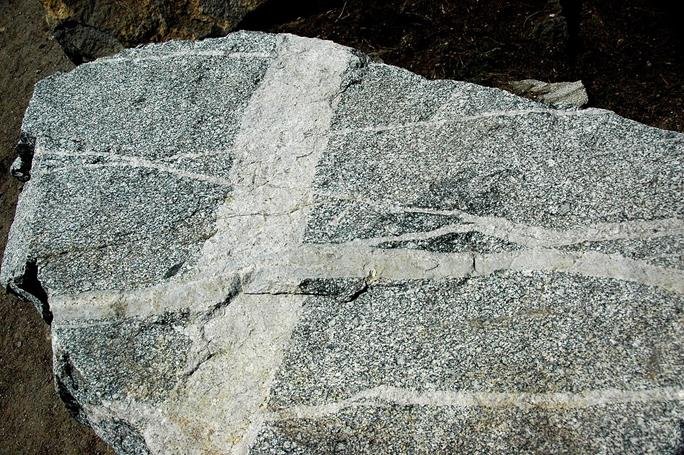Aplite rocks are light-colored intrusive igneous rocks with fine-grained, even, or equigranular sugary or saccharoidal phaneritic texture.
Phaneritic implies you can see and distinguish mineral crystals present without a microscope. Therefore, these rocks don’t have aphanitic texture like basalts or rhyolites.
Grains in these rocks are less than a few mm across, and most have a granitic or granitoid-like composition with mainly feldspar and quartz. These grains are mostly anhedral to subhedral (poorly formed to averagely well-formed crystals).
Also, most of these rocks show compositional layering on a centimeter scale, commonly cuspate. This layering can show deformation evidence.
How do they form? Aplites form from the water-rich residual or last melt to crystallize in large plutons like stocks or batholiths. However, they can occur in some high-grade metamorphic terranes too.
Lastly, aplite is a textural term rather than a composition or rock name. Rocks with this texture or fabric are called aplitic.

More about aplite or aplitic rocks
Aplite or aplitic is a textural term characterized by small or sugar-like grains that occur in coarse-grained plutonic rocks. It doesn’t refer to any specific rock. However, most have a granite-like composition.
When using this name or others like pegmatites, the general rule is to include the rock name. For instance, you can have aplite granite, diorite, gabbro, or granodiorite. However, in most cases, when used alone, aplite means granite.
Alternatively, aplitic can also be a modifier. In this case, you should add the rock name afterwards. For instance, you can have aplitic granite, foid-syenite, diorite, gabbro, etc.,
For the two usages, aplite or aplitic only denotes fine-grained facie in relatively coarse-grained rock. The coarse-grained rock can be granite, syenite, diorite, gabbro, etc.
Usually, the composition of aplitic rocks is the same as that of coarse-grained rock.
Note: Aplite doesn’t refer to medium-grained plutonic rocks like granite that commonly occur as veins. Such are named as micro+plutonic rock name. For instance, you will have microgranite or microgabbro (dolerite or diabase)
Aplite composition
Aplite rocks mainly have quartz and alkali feldspar, usually orthoclase, microcline, or perthite, making them similar to granites. Also, they can have minor muscovite, biotite, and hornblende.
Sometimes, potassium feldspar and quartz often form micrographic intergrowths.
However, some aplitic rocks will have sodium plagioclase, i.e., albite, instead of potassium feldspar.
Lastly, accessory minerals include topaz, garnet, tourmaline, fluorite, and andalusite. Others may have natrolite, spessartite, lepidolite, molybdenite, monazite, etc.
Where is aplite found?
Aplite occurs mostly as small dikes, veins, or irregular patches in pegmatites, granite, granodiorite, and other granitoids or granitic rocks. Most of these dikes and veins are a few centimeters to less than a meter.
However, they can occur in other plutonic rocks, including syenite and diorite.
Lastly, these rocks are usually associated with plutons. They occur inside their parent rocks or can form in nearby country rocks.
Aplites and pegmatites
Pegmatites and aplite rocks often occur together. Those that occur together have the same composition. However, they are marked with an abrupt change in crystal sizes.
In pegmatites, aplites form dikes cutting through pegmatites. However, they more often occur as irregular patches or as zones among coarse-grained pegmatites.
Also, some occur on the edge of a pegmatitic body. However, their fine-grain textures are not due to rapid cooling.
The main differences between aplite and pegmatites are their texture and how they occur.
Usually, pegmatites are coarse-grained rocks with crystals as large as a meter, with those over tens of meters known, while aplitic rocks have a fine-grained texture. Also, they form larger bodies, several hundred meters across.
Lastly, pegmatites show more complexity and come in various shapes, including lenses and irregular bodies. Some are zoned with quartz in the core and muscovite-rich outer edges.
How does aplite form?
Aplite forms from the water-rich last portion of magma melt to crystallize. These are the same melts that form pegmatites, hence the close association.
However, unlike volcanic rocks that form from rapid quenching of magma, aplitic rocks don’t. Instead, conditions that favor quick nucleation – forming embryos upon which crystals grow – influence their formation.
They likely form from sudden loss of fluid in fluid phases or water in water-rich melts.
Water loss will increase the solidus temperature since water works as a flux. This will cause supercooling that triggers sudden nucleation, forming a fine-grained aplitic rock.
On the other hand, rapture in the fluid phase will decrease pressure. This will lower the solidus, triggering quick nucleation.
Frequently Asked Questions (FAQs)
They are used in making statues and in industry to make glass or enamel. Some can contain exotic minerals like beryl and garnets.
Yes. These rocks may also occur in some metamorphic terranes. They occur in migmatites formed from high-grade partial melting of gneiss.
